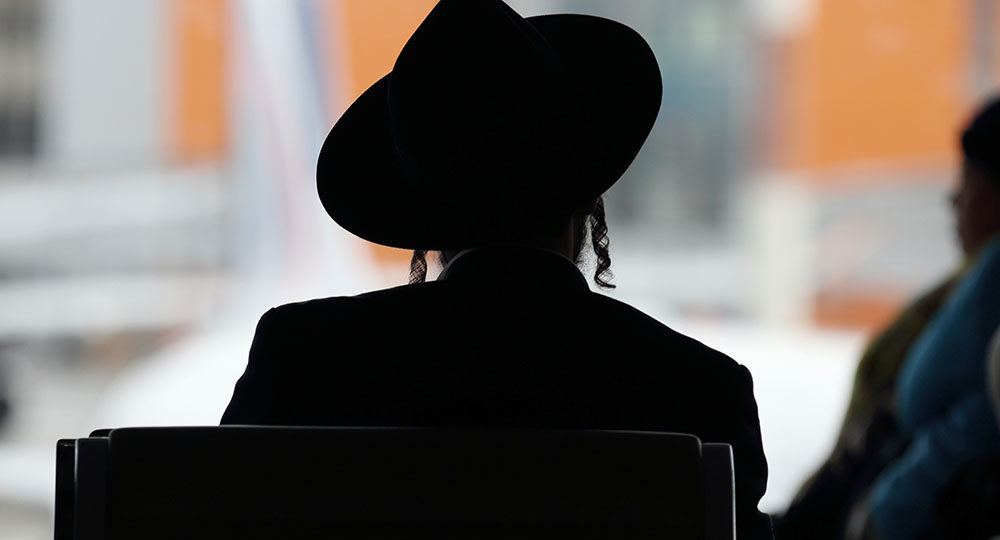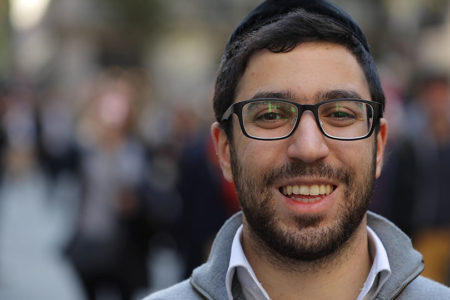Hasidic Judaism
Putting Joy In Judaism
Within the world of Orthodox Judaism there is a group of intensely religious Jews whose influence and significance far outweigh their number. Termed ultra-Orthodox by outsiders, they are more properly known as Hasidic Jews, or the Hasidim. Although there are approximately only 250,000 Hasidim worldwide, the intensity of their devotion is matched by the impact of their influence on Jewish life in general and Israeli politics in particular.
You may have seen pictures of them—bearded men with long side curls, wearing black coats and hats, praying intensely at the Western Wall. Or you may remember scenes of people dressed in that manner demonstrating against some Sabbath infraction in Jerusalem. These are the faces they most often present to the outside world. Within their own cloistered world of tenements and yeshivas, however, is a life that pulses with its own rhythms, joys, and intrigues. To better understand this fascinating group, it is necessary to first look back a few hundred years, as the past often reveals the key to comprehending the present.
The Founder of Hasidism
In the eighteenth century, the largest concentration of Jews in the world lived in Poland, the Ukraine, and the neighboring countries of Eastern Europe. Thousands of study houses called yeshivas were filled with young men poring over ancient Talmudic texts and engaging in spirited discussions about their meanings. A method of study called pilpul sought, by hairsplitting arguments, to prove points about the precise meanings of words and phrases. While this approach to study was defended by some proponents as a means to sharpen the mind, others were concerned that this method resulted in a cold legalism.
In the midst of this Talmudic world arose one of the greatest revivalist movements in Jewish history. A young man named Israel ben Eliezer retired for a period of time to the Carpathian Mountains in Poland and later emerged with mystical ideas that would affect his fellow countrymen in a truly revolutionary way.
Eliezer began to gather disciples, and it was reported that he could perform miracles by using the ineffable name of God. Because of this, he was called the Besht, an acronym based on the Hebrew phrase for Master of the Good Name. In addition to working miracles, the Besht introduced the novel idea that a Jew did not have to study to be pious. In other words, the ignorant could approach God through a joyous spirit. This joy was manifested by prolonged seasons of singing, dancing, and loud praying with much motion and energy. It is not an exaggeration to say that these new ideas and practices spread like wildfire across a dry prairie. By 1800, just 40 years after his death, the movement launched by the Besht numbered a half million Jews in Eastern Europe.
The Besht left no son, but his son-in-law and a series of successors fervently continued his teachings. Hasidic dynasties were founded, each led by what was called a rebbe—a sort of rabbi’s rabbi—whose word became absolutely authoritative to his own Hasidim. While the Hasidim encountered fierce opposition from the Mitnaggedim (opponents), who attacked their lack of emphasis on study, the Hasidic movement eventually crystallized into a major force in Jewish life.
The Ideas of Hasidism
The basic teachings of Hasidism are usually conveyed through stories about the great Hasidic masters or rebbes. The German-Jewish scholar Martin Buber collected and published many of these stories, which remain the best sources for learning about Hasidic thought and life. Among the many ideas that could be mentioned, three form the essence of the movement.
The first is simcha. This Hebrew word means joy. Joy is expressed primarily through Hasidic worship. Although many of the Hasidim may appear quite somber, a visit to one of their gatherings reveals spiritual exuberance and spontaneity of expression. While later generations of Hasidic teachers restored the emphasis on the importance of study, their followers today still express joy in ways that outsiders may deem quite bizarre. Banging on tables and setting off fireworks outside the prayer room are some ways of expressing simcha.
The second is devekut. This Hebrew word means cleaving and is related to the modern Hebrew word for glue. Devekut, or cleaving to the Holy One of Israel, can be attained not only through study and obedience, but through mystical union with the “Endless One.” These deeply esoteric practices are part of the Cabala, an ancient system of mystical philosophy and meditation. Through their holy text, the Zohar, Hasidim are taught to cleave to the Divine, even as they live out their daily lives. This intricate system of spirituality is not intended for the uninitiated. Some texts of Cabala warn that a person is not to study it before the age of forty.
The third is zaddik. This Hebrew word means righteous one. It is applied to an individual who, through study and meditation, has reached devekut and is so close to the Godhead that he serves as a mediator between his followers and the Divine Being. The Hasidic rebbe is a zaddik and is viewed with great reverence and awe by his followers. It is difficult for outsiders to comprehend the absolute devotion felt by Hasidim toward their rebbe. His opinions are accepted and followed without question. His advice is sought for every possible area of life. This nearly idolatrous adulation of the rebbe is one of the biggest objections that non-Hasidic Jews have to the Hasidic way of life.
In a more positive light, Harry Rabinowicz, in Hasidism: The Movement and Its Masters, writes, “From the Hasidic perspective, the man in the marketplace could draw as near to his Father in Heaven as could the scholar in his study. Mystically, almost miraculously, Hasidism brought joy, comfort, and courage to these suffering stepchildren of humanity. It offered a form of otherworldly ecstasy to the ordinary Jew, to the untutored and destitute as well as to the learned and the privileged.”
The Hasidic Movement
While the Hasidim can be found in many countries today, their main centers are in America and Israel. All Hasidim have a common commitment to traditional dress (e.g., black coats and trousers, white shirts, and no ties for men). Most of the men also have side curls—payote in Hebrew—as well as beards. Their wives, who shave their heads after marriage, wear wigs and cotton dresses that tend to be colorful. Large families are very common, and many wives help to financially support their husbands’ long hours of devotion to study.
But these are just the outward trappings of Hasidic life. Each Hasid is characterized by a commitment to “Torah Judaism.” Judaism is not just a part of their life; it is their life, 24 hours a day. As has been mentioned, Hasidim are marked by devotion to their rebbe. A rebbe heads each Hasidic group. There are over a dozen Hasidic dynasties, each with its own internal organization and each known by the name of the town in Europe from which its great man came—Lubavitch, Satmar, Ger, Belz, Vishnitz, Bratslav. While Brooklyn is a main center, there are also large communities of Hasidim in the Israeli towns of Bnei Brak and Kfar Habad. The most colorful center of Hasidic life is the Jerusalem quarter called Mea Shearim, which resembles a shtetl or village from eighteenth-century Eastern Europe, particularly on the Sabbath, when no traffic is permitted. The two largest dynasties, the Lubavitchers and the Satmars, represent the main contrasts in Hasidic practice.
The Lubavitcher Hasidim were founded by Shneur Zalman, who died in 1812. He authored a famous text called the Tanya, which embodies the Hasidic devotion to God and learning. Desiring to reintroduce the emphasis on study, Zalman stressed three concepts: wisdom, understanding, and knowledge. The first letters of these three Hebrew words form the acronym Chabad, which is also another name for the movement.
Headquartered in Brooklyn, the Lubavitcher Hasidim are committed to convincing their fellow Jews to be observant of the Torah. They establish centers for study and charity all over the world and zealously seek to convert their Jewish brothers to the scholarly way of life. They are active on college campuses with their Chabad Houses and are at the forefront of the antimissionary groups that are so active today. Unlike most other Hasidic groups, they are very Zionist and support the State of Israel.
They received much notoriety in recent years because of the brilliant and charismatic leadership of their remarkable rebbe, Menachem Mendel Schneersohn, who died in 1994 after a 40-year tenure marked by the greatest growth of the movement. As Schneersohn aged, more and more of his followers believed him to be the messiah. Although he never formally announced his messiahship, he never discouraged this belief. Since his death, no one has been named to succeed him as the new rebbe.
The Satmar Hasidim, with roots in Hungary, suffered greatly during the Holocaust. Their rebbe at the time, Joel Teitelbaum, made an amazing escape from the Nazis and relocated the headquarters of the group in the Williamsburg area of Brooklyn.
While sharing many of the same ideals with the Lubavitchers, they differ in their isolationism from society in general and opposition to Zionism and the State of Israel. They believe they are responsible to pray for the coming of the Messiah, who will then enable the Jews to return to Israel. Therefore, any effort on the part of Jews to return and refound the ancient state is a human effort cursed by God. Many of their followers live in Jerusalem and often demonstrate against the state if they feel that there has been an infringement on their religious beliefs or practices.
Conclusion
The Hasidim are a colorful Jewish group, but we should avoid an overly romantic view of their lifestyle. They are people like those in any other Jewish group. They are perhaps more difficult to reach with the gospel because of their isolationist lifestyle and their unwillingness to even listen to the message. They are more spiritually resistant to the gospel than other groups you may encounter. Pray that God will raise up concerned believers who are willing to take the good news to them, even if these people do not want to listen. Paul’s word in Romans 10:1–2 is appropriate for the Hasidim: “Brethren, my heart’s desire and prayer to God for Israel is, that they might be saved. For I bear them witness that they have a zeal for God, but not according to knowledge.”








A good source.
I want to get in contact with Orhodox Jews in Nigeria.
Please direct me.